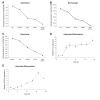Internal control genes for quantitative RT-PCR expression analysis in mouse osteoblasts, osteoclasts and macrophages
- PMID: 21996334
- PMCID: PMC3204251
- DOI: 10.1186/1756-0500-4-410
Internal control genes for quantitative RT-PCR expression analysis in mouse osteoblasts, osteoclasts and macrophages
Abstract
Background: Real-time quantitative RT-PCR (qPCR) is a powerful technique capable of accurately quantitating mRNA expression levels over a large dynamic range. This makes qPCR the most widely used method for studying quantitative gene expression. An important aspect of qPCR is selecting appropriate controls or normalization factors to account for any differences in starting cDNA quantities between samples during expression studies. Here, we report on the selection of a concise set of housekeeper genes for the accurate normalization of quantitative gene expression data in differentiating osteoblasts, osteoclasts and macrophages. We implemented the use of geNorm, an algorithm that determines the suitability of genes to function as housekeepers by assessing expression stabilities. We evaluated the expression stabilities of 18S, ACTB, B2M, GAPDH, HMBS and HPRT1 genes.
Findings: Our analyses revealed that 18S and GAPDH were regulated during osteoblast differentiation and are not suitable for use as reference genes. The most stably expressed genes in osteoblasts were ACTB, HMBS and HPRT1 and their geometric average constitutes a suitable normalization factor upon which gene expression data can be normalized. In macrophages, 18S and GAPDH were the most variable genes while HMBS and B2M were the most stably expressed genes. The geometric average of HMBS and B2M expression levels forms a suitable normalization factor to account for potential differences in starting cDNA quantities during gene expression analysis in macrophages. The expression stabilities of the six candidate reference genes in osteoclasts were, on average, more variable than that observed in macrophages but slightly less variable than those seen in osteoblasts. The two most stably expressed genes in osteoclasts were HMBS and B2M and the genes displaying the greatest levels of variability were 18S and GAPDH. Notably, 18S and GAPDH were the two most variably expressed control genes in all three cell types. The geometric average of HMBS, B2M and ACTB creates an appropriate normalization factor for gene expression studies in osteoclasts.
Conclusion: We have identified concise sets of genes suitable to use as normalization factors for quantitative real-time RT-PCR gene expression studies in osteoblasts, osteoclasts and macrophages.
Figures




Similar articles
-
A new set of reference housekeeping genes for the normalization RT-qPCR data from the intestine of piglets during weaning.PLoS One. 2018 Sep 26;13(9):e0204583. doi: 10.1371/journal.pone.0204583. eCollection 2018. PLoS One. 2018. PMID: 30256841 Free PMC article.
-
Reverse transcription quantitative real-time polymerase chain reaction reference genes in the spared nerve injury model of neuropathic pain: validation and literature search.BMC Res Notes. 2013 Jul 10;6:266. doi: 10.1186/1756-0500-6-266. BMC Res Notes. 2013. PMID: 23841944 Free PMC article.
-
Identification of valid reference genes for gene expression studies of human stomach cancer by reverse transcription-qPCR.BMC Cancer. 2010 May 28;10:240. doi: 10.1186/1471-2407-10-240. BMC Cancer. 2010. PMID: 20507635 Free PMC article.
-
Validation of reference genes for the normalization of RT-qPCR expression studies on human laryngeal cancer and hypopharyngeal cancer.Eur Rev Med Pharmacol Sci. 2019 May;23(10):4199-4209. doi: 10.26355/eurrev_201905_17924. Eur Rev Med Pharmacol Sci. 2019. PMID: 31173291
-
HMBS is the most suitable reference gene for RT-qPCR in human HCC tissues and blood samples.Oncol Lett. 2021 Nov;22(5):791. doi: 10.3892/ol.2021.13052. Epub 2021 Sep 17. Oncol Lett. 2021. PMID: 34584568 Free PMC article.
Cited by
-
TBP, PPIA, YWHAZ and EF1A1 Are the Most Stably Expressed Genes during Osteogenic Differentiation.Int J Mol Sci. 2022 Apr 12;23(8):4257. doi: 10.3390/ijms23084257. Int J Mol Sci. 2022. PMID: 35457075 Free PMC article.
-
Evidence based selection of commonly used RT-qPCR reference genes for the analysis of mouse skeletal muscle.PLoS One. 2014 Feb 11;9(2):e88653. doi: 10.1371/journal.pone.0088653. eCollection 2014. PLoS One. 2014. PMID: 24523926 Free PMC article.
-
Selection of reliable reference genes for the normalisation of gene expression levels following time course LPS stimulation of murine bone marrow derived macrophages.BMC Immunol. 2017 Oct 3;18(1):43. doi: 10.1186/s12865-017-0223-y. BMC Immunol. 2017. PMID: 28974200 Free PMC article.
-
Transcriptional inhibition after irradiation occurs preferentially at highly expressed genes in a manner dependent on cell cycle progression.Elife. 2024 Oct 11;13:RP94001. doi: 10.7554/eLife.94001. Elife. 2024. PMID: 39392398 Free PMC article.
-
A Na+/K+ ATPase Pump Regulates Chondrocyte Differentiation and Bone Length Variation in Mice.Front Cell Dev Biol. 2021 Dec 14;9:708384. doi: 10.3389/fcell.2021.708384. eCollection 2021. Front Cell Dev Biol. 2021. PMID: 34970538 Free PMC article.
References
LinkOut - more resources
Full Text Sources
Other Literature Sources
Research Materials
Miscellaneous

